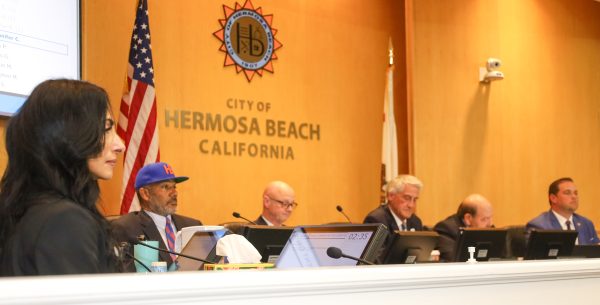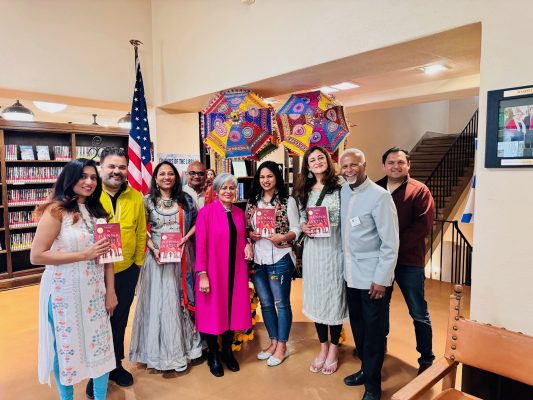
Commissioned by the Metropolitan Opera in New York to commemorate its 100th season, “The Ghosts of Versailles” arrived seven years too late. Nonetheless, this “grand opera buffa,” as composer John Corigliano describes it, is a formidable work in every sense.
Accompanied by William M. Hoffman’s witty and intelligent libretto, “The Ghosts of Versailles,” which premiered in 1991, ostensibly completes the “Figaro trilogy” of Pierre Beaumarchais, the late 18th century French playwright whose earlier works for the stage – “The Marriage of Figaro” and “The Barber of Seville” – were alchemized into operas by, respectively, Mozart and Rossini in 1788 and 1816. The underwhelming hind leg of this dramatic trio, “The Guilty Mother” (La mère coupable), was set by Milhaud in 1965, but apparently without a great deal of success.
Now, after nearly a quarter of a century after its debut, “The Ghosts of Versailles” is having its West Coast premiere courtesy of LA Opera. Passionately conducted by James Conlon, performances continue through March 1.
Realizing that its operatic possibilities were limited, Corigliano and Hoffman kicked the story around and arrived at an intriguing scenario that essentially gives us an opera within an opera, theater within theater, and a foray into the afterlives of Marie Antoinette (Patricia Racette), Louis XVI (Kristinn Sigmundsson), and various courtly aristocrats and nobles, not to mention Beaumarchais himself (Christopher Maltman). Many of those in royal attendance, dressed in white, have black gauze over their heads to give the impression that – yes – they have been victims of Madame Guillotine.
At the same time, composer and librettist have reintroduced many of the familiar faces and voices from the Mozart and Rossini operas – Figaro (Lucas Meachem), his wife Susanna (Lucy Schaufer), Count Almaviva (Joshua Guerrero), Rosina, the Countess Almaviva (Guanqun Yu), and Cherubino (Renée Rapier).
Here in the netherworld, Marie Antoinette is still grieving over a life cut short at the chopping block, and Beaumarchais – very much in love with her – promises to stage a new work in which he will present “history as it should have been.”

Beaumarchais (Christopher Maltman), in white, presents his new play for the pleasure of Queen Marie Antoinette (Patricia Racette), while young lovers Léon (Brenton Ryan) and Florestine (Stacey Tappan) gambol on stage. Photo by Craig T. Mathew/LA Opera
A great deal of credit must be given to scenery designer Alexander Dodge, lighting director York Kennedy, costume designer Linda Cho, projection designer Aaron Rhyne, choreographer Peggy Hickey, and director Darko Tresnjak, among others, but musically Corigliano infuses “The Ghosts of Versailles” with a cinematic sensibility. Movie soundtrack aficionados may remember his score for Ken Russell’s “Altered States” (1981) with William Hurt as a beleaguered scientist à la Jeff Goldblum in “The Fly.”
Because it draws from many sources, soaking up musical pigments from a variety of genres and eras, “The Ghosts of Versailles” is something of a pan-stylistic opera and a showcase for Corigliano’s versatility and mastery of composition. And, it seems, his wizardry. Those extra seven years that the opera demanded evidently weren’t spent playing beach volleyball.
And so, written at the Queen’s behest – “Amuse me, Beaumarchais” – the piece plays out humorously on the stage within the stage and everyone has a good laugh. Except the Queen. She still seems inconsolable.
Now, the play within the play is pure buffa – farcical, bawdy “buffoonery” redolent of late 18th, early 19th century Italian opera. The villain of the piece, Bégearss (Robert Brubaker), is your classic matinee bad guy – all he needs is the Snidely Whiplash moustache – and with his Renfield-like sidekick, Wilhelm (Joel Sorensen), he unleashes havoc into the tale by his treacherous actions that may put us in mind of Robespierre, one of the architects of revolutionary France’s Reign of Terror – literally a rain of terror.
One of the principal plotlines involves Count Almaviva’s plan to sell the Queen’s necklace, the profits from which would help to buy her freedom. But then Bégearss connives to steal the necklace while demanding the hand of Florestine (Stacey Tappan), who is not only Count Almaviva’s daughter (from an unspecified liaison) but is in love with Léon (Brenton Ryan), who is Rosina’s son by Cherubino. There is quite a bit of mayhem here in an Indiana Jones meets the Marx Brothers sort of way, which rises to a first act finale that’s a big nod to “Turkomania” in general and to Rossini’s “The Turk in Italy” (1814) and maybe also “The Italian Girl in Algiers” (1813) in particular.

The highlight of this scenic blockbuster – a lush, operatic bazaar as vibrant as Franco Zeffirelli’s set for “Pagliacci” – is the 10-minute cameo of musical theater superstar Patti LuPone as the Egyptian singer Samira, riding in on a life-size mechanical pink elephant. In this explosive finale, one of Wagner’s valkyries even makes an appearance, singing: This isn’t opera! Wagner is opera!
But sometimes, as even God Himself would acknowledge, the creation gets away from the creator, and Figaro, who has swiped the necklace so as to keep it away from Bégearss, refuses to go by the playbook and return it to Count Almaviva. Beaumarchais admonishes him. Nothing doing, says Figaro. His allegiance is apparently not to the Queen, and our ghostly Marie Antoinette is wounded by this setback. The refrain here is something like “I want to live again, Beaumarchais,” to which the playwright rejoins: “I want to make you happy.” (The King, rather put out by hearing all this dove-cooing, challenges Beaumarchais to a duel and runs him through with his sword. Then everyone explodes in laughter: We’re already dead!)
Not so surprisingly, then, Beaumarchais enters his own play, but not only does he find that he can’t change history, he has forfeited his authorial powers.

The second act may seem weaker because tragedy moves in like a rain cloud and douses any merriment left over from the first half of the opera. The Terror has begun, heads atop pikes are carried in by the mob, and the upper classes are imprisoned.
Awaiting the inevitable, the characters reconcile, and Corigliano gives them an ensemble aria or two that is reminiscent of Mozart at his finest. The video projection greatly enhances the sense of rampant lawlessness, and while the story for some viewers may call to mind “Les misérables,” for me it recalls the 2009 exhibition at the Getty Center entitled “Cast in Bronze: French Sculpture from Renaissance to Revolution,” with its underlying reminder that so much exquisite art was looted and destroyed during these combustible years.

There is a bittersweet ending in store, and a poignancy that Patricia Racette convincingly conveys as the doomed Queen. There is, finally, an acceptance of her fate, and a peaceful resignation. “Let it be” is what she essentially tells her beloved Beaumarchais, for this is what will in the end set her “free.” If history is changed, as Beaumarchais has desperately been trying to do for her, then Marie Antoinette will lose her beloved playwright – and she sadly realizes this.
Corigliano carries us from one extreme to another, with music that weaves in and out from the wispy and the ethereal to the muscular, and sung by performers – the delightful Maltman and the enchanting Yu for starters – of whom many are making their company debut, and doing it brilliantly.
I had wondered if we would again be blessed with anything this extravagant from LA Opera. It’s a costly production, but the money spent on it is onstage to be seen and heard. However, it’s only money well-spent if people go to see it. And it should be seen.
The Ghosts of Versailles, receiving its West Coast premiere, is now at the Dorothy Chandler Pavilion, 135 N. Grand Ave., downtown Los Angeles in the Music Center. Performances, Wednesday, Feb. 18, at 7:30 p.m.; Saturday, Feb. 21, at 7:30 p.m.; Thursday, Feb. 26, at 7:30 p.m.; and Sunday, March 1, at 2 p.m. Tickets from $17. Call (213) 972-8001 or go to LAOpera.org. Email questions to laopera@laopera.org. ER










